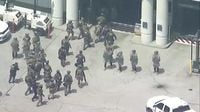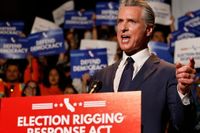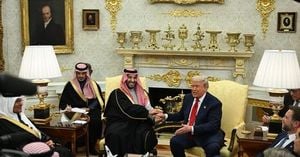On August 14, 2025, the usually tranquil Little Tokyo neighborhood of downtown Los Angeles became the unlikely epicenter of a political and law enforcement drama. As California Governor Gavin Newsom took the stage at the Japanese American National Museum to unveil his latest plan for redistricting, a large contingent of federal agents—about 100 strong, according to eyewitness reports—gathered just outside the venue. What unfolded was a collision of politics, law enforcement, and public perception that quickly drew national attention.
The governor’s press conference was already set to be a high-stakes affair. Newsom, a prominent Democrat and potential 2028 presidential contender, was there to announce a bold proposal: bypassing California’s independent redistricting commission and putting new, more partisan congressional maps directly to the voters in a special election on November 4. This move, he argued, was a direct response to Republican-controlled Texas’s recent efforts to redraw their own congressional districts mid-decade, a maneuver that could net the GOP at least five additional House seats ahead of the 2026 midterms, according to Nexstar Media Inc.
But the focus quickly shifted from political maps to the heavy federal presence just outside. Newsom’s office, never one to shy away from a public spat, took to social media with a message that mimicked the bombastic style of former President Donald Trump: “BORDER PATROL HAS SHOWED UP AT OUR BIG BEAUTIFUL PRESS CONFERENCE! WE WILL NOT BE INTIMIDATED!” This post, shared on platform X, set the tone for a day that would be as much about optics and messaging as about policy substance.
The Los Angeles Police Department, for its part, issued warnings about traffic disruptions due to the federal agents’ presence in Little Tokyo. Meanwhile, the local and national press scrambled to understand whether the timing of the immigration enforcement operation was mere coincidence or something more calculated. According to ABC News, at least one individual was detained during the operation, though details about the arrest remained sparse as the story developed.
Governor Newsom did not mince words about what he saw as the real motivation behind the federal show of force. “Do you think it’s coincidental? Donald Trump and his minions, [border czar] Tom Homan, tough guy, clearly decided, coincidentally, or not, that this was a location to advance ICE arrests,” he said, as reported by KABC. Later, he sharpened his criticism, calling the Border Patrol presence “sick and pathetic” and adding, “It just said everything you need to know about the setting that we’re under. That they chose the time, manner, and place to send their district director outside right when we’re about to have this press conference. It’s everything we know about Donald Trump’s America.”
Los Angeles Mayor Karen Bass echoed the governor’s indignation. In her remarks to reporters, she insisted there was “no way this was a coincidence,” given how widely publicized the press conference had been. “They decided they were going to come and thumb their nose in front of the governor’s face,” she said, quoted by KTLA. “Why would you do that? That is unbelievably disrespectful, it’s a provocative act. They’re talking about disorder in Los Angeles, and they are the source of the disorder in Los Angeles right now.” Bass went further, dismissing the idea that the operation was about public safety: “This is just incredible. I heard Bovino say that he was here to make Los Angeles safe. This is not making Los Angeles safe... This is a complete problem, nothing to do with safety. In fact, this is the exact opposite of keeping our city safe. We do not need them here, and they have no business to come here and provoke this.”
Yet, federal officials were quick to push back against any suggestion of political motivation. Gregory Bovino, chief patrol agent of the El Centro Border Patrol sector and the operation’s commander, addressed the media directly. “Today, Customs and Border Protection is conducting roving patrol duties here, as you can see, in downtown Los Angeles. This is a location that we have conducted these roving patrol duties for the past two months. We’ve been here over two months, and as you can see today, we did make an apprehension just a few feet from where I’m standing,” Bovino explained, according to KABC. When pressed about the timing, he was unequivocal: “Breaking the law is not coincidental. Breaking the law is breaking the law. There’s no coincidence in breaking the law. So when they break the law, you can expect that you’re probably going to get arrested.”
The Department of Homeland Security also weighed in to tamp down the controversy. Assistant Secretary for Public Affairs Tricia McLaughlin posted on X that “Mayor Bass must be misinformed. Our law enforcement operations are about enforcing the law—not about Gavin Newsom. @CBP patrols all areas of Los Angeles every day with over 40 teams on the ground to make LA safe.” Her statement was echoed in multiple outlets, including ABC News and KTLA, as federal officials sought to assure the public that their actions were routine and not politically motivated.
For many Angelenos, the day’s events were a jarring reminder of the tensions that can erupt at the intersection of immigration enforcement and high-profile politics. The city, home to one of the nation’s largest immigrant populations, has long been a stage for clashes between local leaders and federal authorities over how immigration laws are enforced. Thursday’s events only added fuel to that ongoing debate.
At the heart of the storm, Newsom’s redistricting proposal risked being overshadowed by the controversy. Yet, the governor remained focused on his message, framing the ballot measure as a necessary counterpunch to what he described as partisan overreach in Texas and other Republican-led states. “People are scared. People are fearful,” Newsom said, referencing past incidents where Democratic officials, like Senator Alex Padilla, had faced federal intervention. Redistricting battles, he argued, were not just about lines on a map but about the broader fight for democratic norms and representation.
As the dust settled, both sides remained entrenched. Local officials and progressive activists viewed the federal operation as a deliberate provocation and a chilling signal to immigrant communities. Federal authorities, meanwhile, insisted they were simply doing their jobs, enforcing the law impartially and without regard to the governor’s schedule.
One thing was clear: the events of August 14, 2025, laid bare the deep divisions—political, procedural, and philosophical—that continue to shape the national conversation around immigration and electoral fairness. With the November special election looming and redistricting battles raging across the country, Los Angeles’s day in the spotlight was unlikely to be the last of its kind.





